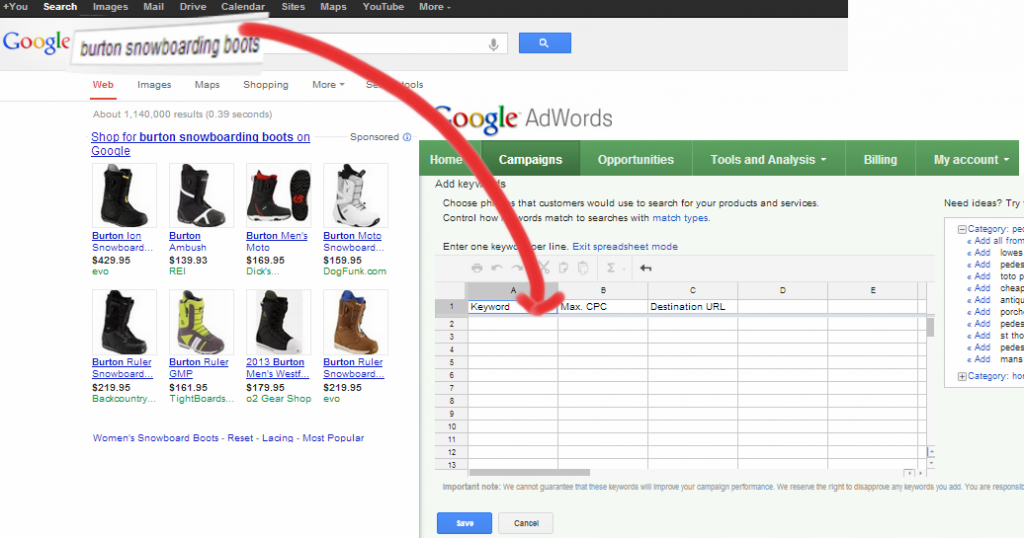Find New PPC Keyword Opportunities With Google Shopping


Google, over the past 5 years, has accumulated massive amounts of data about product-related user queries, slowly building their understanding of what is and isn’t a commercial, or transactional, query. They’ve recently used this product search algorithm to build a new ecommerce focused advertising platform for retailers called Google Shopping, or Product Listing Ads.
Google Shopping employs what are called Product Listing Ads from the Google Adwords advertising platform to create shopping ads relevant to a user’s search query. Despite being in the early months of the program, what’s been incredibly impressive during the transition to a paid shopping platform is the quality of those ad clicks (generally speaking of course). Google Shopping, more commonly referred to here as PLAs, have led to highly qualified clicks from users that ultimately result in higher than average conversion rates.
How do we explain this? Are the shopping ads simply doing a better job of priming users to want to purchase an item? Are the ads so flashy that users just can’t resist the urge to add to cart? Maybe it’s just connecting users with the right intent with the appropriate shopping ads….
Google’s employing their ‘new’ understanding of product search to identify searches that are commercial and transactional in nature. This means that in addition to mapping advertisers’ keywords to the search queries of human users, they’re now mapping user intent as well (is the query related to a specific product and are they looking to potentially purchase?). If the intent is transactional, Google will show a shopping ad that has a product image and possibly a promotion from that particular retailer. If it’s not transactional, Google may try to stick to text ads so that they don’t “clutter” the SERP or provide an irrelevant user experience.
So Google is actually qualifying your ads for you! Isn’t that great to hear?? Finally Google is on your side! But all joking aside, this is wonderful new for advertisers.
But can you learn anything from Google’s advanced product search algorithm? Is there a way for you to harness some of that intent-matching mojo that Google’s using to serve high converting shopping ads to your target customers? The answer is ABSOLUTELY.
What search terms are humans entering in to Google to find your shopping ads? Which of those have led to actual transactions? You can access all of this information in the Adwords UI – just go to the product target / ad group in question and select See Search Terms > All (or Selected, depending on where you are in your account).

Once you’re there, sort by conversions and you’ll have a list of REAL, human search terms that have actually converted. That means that these keywords had a transactional intent when they were typed in to Google. In other words, this is exactly where you want to be advertising and capitalizing on more advertising real estate. If you can list both text ads and shopping ads side-by-side you’ll increase the chances of a user actually coming to your site for that transactional keyword.
Sure it will. Introducing more options for users means that you will ultimately see a loss in traffic to one specific type of ad. However, the net change in overall traffic should be positive since you’re now giving the user more chances to click on an ad that belongs to you.
#Fullofwin.
So to summarize, this is what you should be doing with you Google Shopping search terms:
1. Download search terms that have triggered you Google Shopping ads (PLAs)
2. Sort by Conversions.
3. Use these search terms that have a proven history of converting in the past to build new
keyword lists.
4. Try different match types and bid levels to test the effectiveness of these new keywords.
5. Profit.
And that’s all! Now you have a slightly more robust keyword list in your arsenal and you’ve effectively capitalized on Google’s amazing ability to match a user’s intent to an advertiser’s ad. Feels good right?
When it comes to PPC management this is only the tip of the iceberg and our work is only just beginning, but we’re taking steps in the right direction. If you’re already leveraging this data then you’re strides in front of your competition so keep up the good work!
